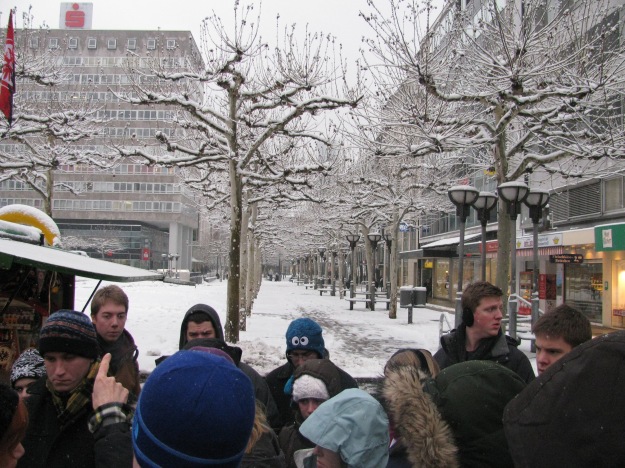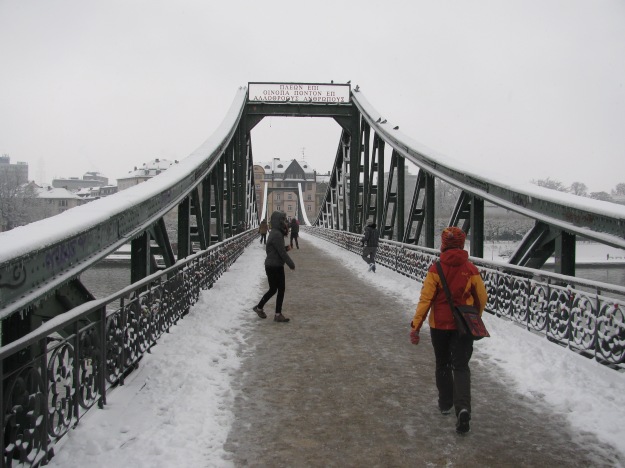Monday was a peculiar day for Frankfurters. Overnight snow and freezing rain accumulated on wires that run the city’s street cars, turning the trams into snow-covered statues. Some area children got the day off from school, and the winter weather delayed the commute for a good number of the estimated 500,000 who come into this city of 700,000 each day for work, school, tourism, shopping or other activities. The airport canceled more than 200 flights on Sunday, and we’re hopeful that the weather improves before our scheduled Thursday departure for the U.S.

Rows upon rows of small plaques document the human toll inflicted on Frankfurt Jews at the Holocaust Memorial Wall.
The weather didn’t deter our Gutenbergers, who were on the streets just after 9 a.m. for a walking tour. One of the first stops was particularly appropriate given our class’s thoughtful discussions the previous evening on what we had witnessed at Dachau and Nuremberg. The Jewish Holocaust Memorial Wall contains more than 11,000 small plaques honoring each Frankfurt Jew who perished in the Holocaust, or whose fate in the concentration camps was unclear. The memorial speaks on two levels – the individual stories are told by name, camp, date of birth, and when known, date of death. From a distance, the rows upon rows of tiny plaques underscore the scale of the horrible human toll inflicted on inhabitants of just one city.
Walking on, one quickly becomes aware that Frankfurt is a city of abrupt contrasts. This is no better exemplified than the area near the intersection of Berliner Straße and Domstraße. On one side of the street are mundane 1950s-era flats that were hurriedly built in the aftermath of World War II. Across the street sits the angular Museum of Modern Art, constructed in 1991 and lovingly called the “piece of cake,” as its boundaries were wedged into a triangular city block. In the distance, one can see the modern skyscrapers that speak to Frankfurt’s spot as a major global economic center. Just a few steps away is the Frankfurter Dom, a Catholic cathedral which dates from the 14th century and where emperors for the Holy Roman Empire were once elected. Although the church was damaged in World War II, much of the sandstone structure remained, unlike much of the rest of the city center, which was flattened by allied bombs. The tudor and half-timber structures that evoke the 16th century were actually constructed in 1986 as part of a move to recreate part of the city’s heritage.
For many of our students, the highlight was no doubt a lunch stop at Kleinmarkthalle, which is quite simply the finest fresh food market most of us will experience in our lifetimes. The first floor has an expansive selection of fresh fruits and vegetables, meats, baked goods, warm food stands with a plethora of ethnic selections, and countless other culinary delights. Free samples were plentiful, which led to a number of takeaway purchases. The chocolate-covered coffee beans were a popular choice for later snacking; this writer will be packing some wasabi-covered peanuts back to the States.
We then made our way to the Geldmuseum (Money Museum), which as the name indicates documents not only the change to the Euro but more broadly the history of money throughout the ages. One doesn’t expect to see a stuffed cow, but it makes sense as barter was the early means of exchanging goods. The museum had a multitude of interactive exhibits that explained more modern-day monetary policy and allowed our students to make multinational fiscal choices. The results (most who tried the latter challenge crashed their economies) underscored that most of our students should stick to communications careers.
As I write, many students are headed south of the river to sample the restaurants and nightlife of Sachsenhausen, the other major district of the city. We’ll return across the river Wednesday to experience more of the city’s museums.
– makemson
Images from a cold day In Frankfurt
I have very little to add to Harlen’s fine summary of the day above, but here are some more photos of our trek around the city.

The trees in this city square and along the Main River in the middle of Frankfurt are a breed of sycamore. They are beautiful in both winter and summer.

These tiny plaques on a snow covered sidewalk rest in front of the location of a house where this family lived prior to being forced into concentration camps.

Students listen to our guide explain the list of more than 11,000 names on the city’s Holocaust memorial, including that of Anne Frank.

Students listen to the history of the various elected emperors in the cathedral where they were crowned over the centuries. The 14th century chapel in the next photo is where the ceremony took place, and it is now open daily for prayer.

We like to refer to this as the “fake square” (well, I do anyway) since it was built in the 1980s to resemble buildings destroyed in WWII American air raids. Students were slightly appalled that church towers were used to guide the bombings into the city centers in an era of less precise navigation tools.

The Eiserner Steg Bridge, or iron bridge, is a walking bridge spanning the Main River. It is a favorite spot for couples to place a lock and throw the key in the river to declare their love. Proposals have been known to take place here.

Emily, Libby, and Lizzie savor the goodies at Frankfurt’s Market Hall. This is one of our favorite spots.

Students pet the stuffed dead cow at the entrance to the Money Museum. Roger Gant answered correctly that such animals served as means of commerce in a time before currencies were established.

No doubt the Money Museum Gardens are lovely in springtime, but the winter trees have their own kind of beauty.

Our favorite workspace is the dining car on the DB trains that whiz through the countryside at 195 km/h. Oh, Amtrak, if you could only be like a German train…

Makemson tries a menu item at the historic Augustiner in Munich called “The big red sausage.” And it was.
AND ONE MORE

We spotted Elon’s mascot, the phoenix, rising on the side of this building in Frankfurt. The city rose from the ashes of war, like the university rose from the ashes of the devastating 1923 fire.
-A. Hatcher








